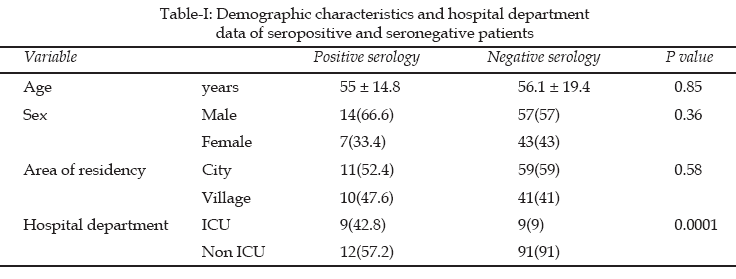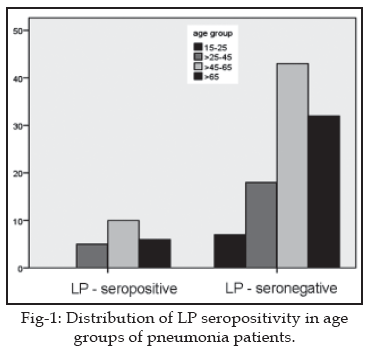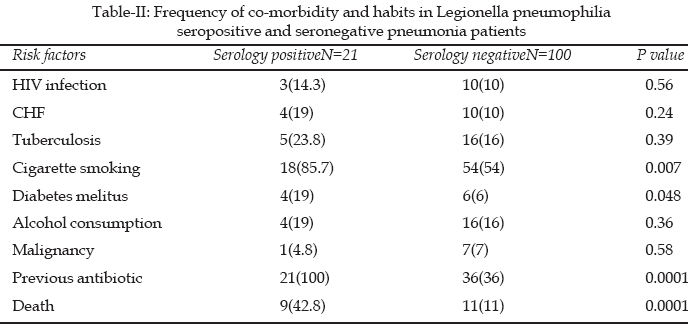|
|
||||
|
Published by : PROFESSIONAL MEDICAL PUBLICATIONS |
||||
|
ISSN 1681-715X |
||||
|
||||
|
|
||||
|
- |
||||
|
ORIGINAL ARTICLE |
||||
|
- |
||||
|
Volume 25 |
October - December 2009 (Part-I) |
Number 5 |
||
|
|
||||
|
||||
Seroprevalence of Legionella pneumophila in admitted
patients with pneumonia in training hospitals, Ahvaz, Iran
Seyed Mohammad Alavi1, Naser Moshiri2,
Moosavian M3, Yusefi F4, Abbasi E5
ABSTRACT
Objectives: To determine the seroprevalence of Legionella pneumophila (LP) in patients with pneumonia.
Methodology: During a 12-month study period, from December 2007 and November 2008 121 randomized selected patients admitted to the three training hospitals of Jundishapoor University of Medical Science in Ahvaz (a city southwest Iran) with pneumonia were investigated to determine the serprevalence of LP. The diagnosis of LP infection was based on positive serology. Sera were tested for L. pneumophila IgG and IgM by using Elisa kit (Vircell, Spain). All analyses were done using the SPSS, version 16 statistical package.
Results: Of a total of 121 serum samples tested, 21 (17.3%) were positive for LP- IgG, IgM. Fifty percent of pneumonia patients in ICU were seropositive. Age, gender and area of residency did not significantly (p >0.05) affect the seroprevalence of LP. Overall, the prevalence of LP seropositivity was not significantly (p >0.05) affected by co-morbidities except diabetes melitus. Smoking and receiving antibiotic was observed in 86% and 100% seropositve patients.
Conclusion: Legionella pneumophila is a prevalent infectious agent in the region of study and should be considered as potential invader patients with pneumonia especially in diabetic, smoker and ICU patients.
KEYWORDS:
Legionella pneumophila, Pneumonia, Seroprevalence, Ahvaz.Pak J Med Sci October - December 2009 (Part-I) Vol. 25 No. 5 811-816
How to cite this article:
Alavi SM, Moshiri N, Mmoosavian M, Yusefi F, Abbasi E. Seroprevalence of Legionella pneumophila in admitted patients with pneumonia in training hospitals, Ahvaz, Iran (2007-2008). Pak J Med Sci 2009;25(5):811-816.
1. Dr. Seyed Mohammad Alavi, MD.
Associated Professor of Medical College,
2. Dr Naser Moshiri, MD
3. Dr Mojtaba Moosavian, PhD.
Associated Professor of Medical College,
4. Dr Farid Yusefi, MD.
AssistantProfessor of Medical College,
1,2,4: Infectious disease ward,
Razi Hospital, Iran.
1-4: Joundishapour Infectious and
Tropical Diseases Research Center,
Iran.
5. Effat Abbasi, MS.
Joundishapour University of Medical Sciences,
Ahvaz, Iran,
Joundishapour Infectious Diseases and
Tropical Medicine Research Center,
Iran.
Correspondence
Dr. Seyed Mohammad Alavi, MD.
Associated Professor of Medical College,
Infectious & Tropical Diseases Research Center,
Infectious Disease Ward,
Razi Hospital, Iran.
Maling Address: No: 52,
West 11 Avenue,
Kianabad,
Ahvaz, Iran
Email:alavi1329dr@yahoo.com
* Received for Publication: March 9, 2009
* Accepted: July 25,2009
INTRODUCTION
Legionella pneumophila (LP) is an important infectious agent for pneumonia.
1 Clinically, Legionella pneumonia doesn’t differ from other pneumonias and presents with fever, cough, and progressive respiratory distress.1-4 Legionella pneumonia can be either community acquired or hospital acquired.1,3,4 True prevalence of LP remains unclear because of unrecognizable, empirical treatment and recovery.4 Death rates are therefore difficult to assess. It’s estimated that about 10% to 15% of patients with Legionella pneumonia die, with the higher mortality occurring in untreated nosocomial cases.1,4 Contaminated water sources, reservoirs and systems such as evaporative condensers of air-conditioners are known to be the main transmission routes of Legionella spp. which are ubiquitous aquatic bacteria.1-7 By virtue of this point peoples living in warm climate area are considered as at risk population due to the direct and prolonged exposure to air-conditioning and air-circulating systems.1,4 Legionella is also transmitted by micro aspiration of Legionella-contaminated water during drinking, oral care, dental procedures, or nasogastric tube insertion.1,4,6 Severely immunocompromised patients (e.g. solid organ and bone marrow transplanted patients, oncology patients, those with HIV infection or end-stage renal failure) are most susceptible to infection.1,4,6 Legionella is a fastidious organism and has very specific growth requirements for culture.4 Simple urinary antigen screen for LP serogroup-1 has become the most frequently used test for Legionella.6 Both culture and urine antigen tests are useful only for one species and can’t detect other types of Legionella.1,6 Tests of antibody titer levels are useful for seroepidemiological studies.1,6,8-12 Knowing the prevalence of LP in a population helps physician to manage appropriately the patients with pneumonia by effective antibiotic against LP. Legionella pneumonia is treated easily with any one of several widely used antibiotics: azithromycin, erythromycin, ciprofloxacin and levofloxacin.1,4,6 According to epidemiological evidences such as long duration of expose the population to air conditioners and cooling systems, the rate of LP seropositivity is expected to be high in Khuzestan. There are very few published studies about LP and its seroprevalence in Iran13-16 thus, epidemiological status of the organism in the most parts of the country is yet unclear. We found only three published seroprevalence study conducted in Tehran and Isfehan. The aim of this study was to investigate the rate of LP seropositivity in patients with pneumonia and probable related risk factors in Ahvaz.METHODOLOGY
Khuzestan is a province located in the south west of Iran. Ahvaz is the capital city of Khuzestan with a population of 1.2 million. Pneumonia is a common infectious disease and is expected to be a major cause of death in Ahvaz. More than 6 months of the year the weather is as warm as the population need to expose the air conditioners and air cooling systems. This study was conducted to determine the frequency of Legionella pneumophila antibodies in patients with pneumonia in training hospital in Ahvaz.
Pneumonia patients admitted in Razi, Imam and Golestan hospitals affiliated to Jundishapoor University of Medical Sciences between December 2007 and November 2008 were studied. Sample size of 121 patients was calculated by statistic formula (n=S
2 ×P2/D2). Patients with pneumonia admitted to the hospital were included in the study. All patients included in the study had initial clinical presentations and chest radiograph findings that were consistent with pneumonia. Patients were excluded from the study if the age was below 15 year or their clinical history was either not available or incompatible with pneumonia.Of total pneumonia patients 121 patients were randomly selected. Data including: demographic, medical history, co-morbid diseases, smoking, alcohol consumption, department (where patient was admitted), area of residency, HIV infection, previously received antibiotic and disease outcome were collected. Blood samples (5 cc sera of each patient before antibiotic initiation) were collected aseptically using veinpuncture techniques by qualified personnel. Serum samples were frozen(-20îc) until examination performance. All Legionella antibodies testing for three hospitals were performed in one centralized laboratory (microbiology department of medical college). LP antibodies testing were performed by enzyme-linked immunosorbent assay method using Vircell Legionella pneumophila seregroup 1-6 Elisa IgG + IgM with sensitivity 95% and specificity 98%. According to manufacturers guide, antibody index was calculated. Samples with index below 9 was considered as negative. Samples with equivocal results (index between 9 and 11) retested. LP-Elisa IgG + IgM was considered positive if index was more than 11. Finally patients were placed in two groups: seropositve group and seronegative group. Two groups were compared. All analyses were done using the SPSS statistical package. The Student’s t test was used to compare the continuous characteristics of age and Fisher’s Exact Test or chi2 test were used to compare the groups’ characteristics and the proportions of patients. Differences with P value lower than 0.05 was considered statistically significant.RESULTS
Twenty one pneumonia patients had positive result for LP antibodies. Thus, seroprevalence rate of LP in patients with pneumonia in Ahvaz was 17.1%. The demographic characteristics and hospital department in which patients were hospitalized shown in Table-I were comparable between the two groups. There were more men than women in both groups, but there was no significant difference in sex between two groups (P=0.36) The only statistical difference between the groups was the greater proportion of seropositive patients who were hospitalized in intensive care unit (ICU) (48.2% vs. 9%, respectively; p = 0.0001).

There was no significant age difference between two groups (55 ±14.8 vs. 56.1± 19.4 respectively; P =0.85). As shown in Figure 1 most prevalent age group in both groups was 45-65 year.

Table-II summarizes the results of LP seropositivity among pneumonia patients regarding their co morbid conditions. Smoking in the LP seropositive group with the rate of 85.7% was significantly higher than seronegative group with the rate of 54%(P=0.007%). Receiving antibiotic before diagnosis in seropositive patients was significantly higher than in seronegative patients (P=0.0001). Death rate in seropostive group was significantly more than seronegatie group (P=0.0001). There was more diabetic patients in LP seropositive group than in seronegative group (P=0.048). Frequency of HIV infection, congestive heart failure(CHF), alcohol consumption and malignancy were similar in both group (P>0.05).

DISCUSSION
In this study, seroprevalence rate of Legionella pneumophila in admitted patients with pneumonia was 17.1%. The prevalence of LP has an uneven geographical distribution in the world, ranging from 0.65% in Austria to 31.7% in Trinidad.
3,14-19 Previous studies in Iran14-16 had indicated this rate between 2.5% to 8.4%. Although the reason for this differences is not completely clear, but we think that some factors such as variation in climate, direct exposure to contaminated water sources, LP seroprevalence in normal population,20-22 severity of illness, previous antibiotic, smoking and frequency of co morbid disease (e.g. diabetes and solid organ transplantation) is linked to this subject. The present study showed that LP seropositivity is associated with high mortality rate. Death rate in seropositive patients was higher than seronegative patients (48.2% vs.11%). Although, it is difficult to say death is caused by LP infection but, it is better to think that LP infection may play a role in the severity of pneumonia. The death rate in our study was higher than the rate of Carol, et al report.21 This study showed that variables such as age, gender and area of residency did not significantly (p >0.05) affect the seroprevalence of L P.This finding is similar to previous studies.19,23In our study we found that overall, the prevalence of L P seropositivity was not significantly (p >0.05) affected by co-morbidities such as CHF,HIV infection,tuberculosis,alcohol consumption and malignancy. Only diabetes mellitus weakly affected (P=0.048) the LP seropositivty. As explained in literature severely immuno compromised patients e.g. oncology patients, chronic heart and lung diseases, those with HIV infection or end-stage renal failure, and others are most susceptible to infection.
1,4,6,13 However, Legionella doesn’t commonly infect people who are HIV positive, probably because they often receive long-term trimethoprim–sulfamethoxazole (which is also active against Legionella) prophylaxis for Pneumocystis carinii pneumonia.4,24 Older people and those with chronic lung and heart disease also are susceptible.1,4,13Legionella also doesn’t commonly infect tuberculosis patients undergoing treatment with antibiotic regimen including rifampicin, which is highly active against Legionella.1,6 It is difficult to discuss why other co morbid diseases had no effect on LP seropositivity. We think that small number of seropositive patients make statistical comparison impossible. Cigarette smoking and receiving antibiotic was observed in 86% and 100% seropositve patients. This finding is consistent with previous studies. Cigarette smoking is a well known risk factor for LP infection.1,4,6,23 Many physicians treat less severe cases of pneumonia only with beta-lactam antibiotics, which are ineffective against Legionella.1 In the region of study similar to other parts of the world, most of the patients (specially seropositive) were started on a regimen of beta-lactam therapy alone. Only when positive clinical or epidemiological evidence existed did appropriate anti-Legionella therapy begin. Receiving ineffective drugs places the patients in the group with high frequency of LP infection.
Limitations of the study: The study has several limitations. One limitation is the small number of seropositive patients. The number of patients having some co morbid disease was so small that it made impossible to compare them. A second important limitation is patients who were admitted in hospital. In the region of study only patients with severe disease are referred to hospitals, so severe disease may overestimate the prevalence of LP infection. One other possible limitation of this study was the training hospitals. In the region of study some patients prefer to go to hospitals without medical students, they think their disease can not be appropriately managed by students. Further study including large sample size in all hospital of the region is needed for determining of risk factors for LP infection.
ACKNOWLEDGEMENTS
We wish to thank Joundishapour Infectious and Tropical Disease Research Center for financial support, laboratory staff of microbiology department of medical college for technical support of this study (Assistance Dissertation). And we acknowledge the personnel of Razi, Golestan and Imam hospitals for their kindly cooperation.
REFERENCES
1. Edelstein PH, Cianciotto NP. Legionella. In: Mandell GL, Bennett JE, Dolin R. (editors). Principle and Practice of infectious diseases. 6th ed., USA, Philadelphia; Churchill Livingstone, 2005;2711-2724.
2. Malan AK, Martins TB, Jaskowski TD, Hill HR, Litwin CM. Comparison of Tow Commercial Enzyme –Linked Immuno Sorbent Assaye with Immunofluorescence Assay for Detection of Legionella Pneumophilla Type 1 to 6. J Clinical Microbiology 2003;41(7):3060-3.
3. Den Boer JW, Yzerman EP. Diagnosis of Legionella Infection in Legionnaires’disease. Eur J Clin Microbiol Infect Dis 2004;23(12):871-8.
4. Todd B. Legionella Pneumonia: Many cases of Legionnaire disease go unreported or unrecognized. Am J Nurs 2005;105(11):35-6, 38.
5. Moosavian M. Isolation of Legionella Pneumophilla Seregroup 1,8 and 10 (causative Agent of Legionnaires’ Disease) from water Sources in Tehran, Iran. Iranian Biomed J 1998;83-7.
6. Change FY, Yu VL. Legionella Infection. In Kasper AS, Hauser SL, Longo DL, Jameson JL. (edts). Harrison’s Principles of Internal Medicine, 16th Edition, New York, Mcgraw-Hill Companies 2005;870-74.
7. Barry SF. Legionella and Legionnaires’ Disease:25 years of Investigation. Clinical Microbiology Reviews, 2002;1(3):506-26.
8. Diederen, BM. Kluytmans, JA, Peeters, MF. Evaluation of vircell Enzyme-Linked Immunosobent Assay and Indirect Immunoflucrescence Assey for Diagnosis of Antibodies Against Legionella Pneumephilla. Clin Vaccine Immunol 2006;13(3):361-4.
9. Aria C. Community outbreak of Legionnaires’disease in Vic-Gurb,Spain in October and November 2005. Euro surveillance, 2007;12(3)78-81.
10. Boshuizen HC, Den Boer JW de Melke H. Reference Values for the SERION classic ELISA for Detecting Legionella pneumophila Antibodies. Eur J Clin Microbiol Infect Dis 2003;22(11):706-8.
11. Cunha BA. The Atypical Pneumenia: Clinical diagnosis and importance. Clin Microbiol Infect 2006;12(3):12-24.
12. Nagelkerke NJ, Boshuizen HC, de Melker HE, Schellekens JF, Peeters MF, Conyn-van Spaendonck M. Estimating the incidence of subclinical infections with Legionella Pneumonia using data augmentation: analysis of an outbreak in The Netherlands. Statist Med 2003;22:3713-24.
13. Moosavian M. First Report on CO-infection of Legionellcsis and Tuberculosis in Iran. Medical J Islamic Republic of Iran 1994;8(3):191-3.
14. Goodarzi H, Jamaati HR, Noroozi J. Comparative evaluation of Legionella diagnosis by culture and urine detection in acute respiratory infection patients. Shahid Beheshti J Med Investigation 2005;29(4):351-55.
15. Yazdani R. Diagnosis of legionella pneumophila by culture and direct fluorescent antibody in bronchoalveolar lavage samples in pneumonia patients reffered to Isfahan medical centers. Shahid sadoghi Med J 2006;14(4):64-8.
16. Mirkalantari S, Mobarez M. Isolation of Leginella from bronchoalveolar lavage samples by culture and polymerase chain reaction. Moddares J Med 2007;10(3):75-83.
17. McIntyre M, Kurtz JB, Selkon JB. Prevalance of antibodies to 15 antigens of Legionellaceae in patients with community-acquired pneumonia. Epidemiol Infect 1990;104(1):39-45.
18. Friis-Møller A, Rechnitzer C, Black FT, Collins MT, Lind K, Aalund O. Prevalence of Legionnaires’ disease in pneumonia patients admitted to a Danish department of infectious diseases. Scand J Infect Dis 1986;18(4):321-8.
19. Nagalingam NA, Adesiyun AA, Swanston WH, Bartholomew M. Seroprevalence of Legionella pneumophila in pneumonia patients in four major hospitals in Trinidad and Tobago. West Indian Med J 2005;54(6):375-8.
20. Haraldsson S, Rechnitzer C, Friis-Mller A. Scand J Infect Dis 1990;22:445-9.
21. Joseph CA, Harrison TG, Ilijic-Car D, Bartlett CL. Legionnaires’ disease in residents of England and Wales.1998. Commun Dis Public Health 1999;2:280-4.
22. Lee HK, Woo MK, Ju YI, Baek SJ, Song HJ, Choi JS. Prevalence of antibodies in response to Legionella species, analysis of a healthy population from Jeollanam-do Province, Korea J Microbiol 2008;46(2):160-4.
23. Wang J, Marguerite S, Brown-Schlumpf. Seroprevalence of legionella in Shanxi Province, China. Infection J 2005;16(3):179-182.
24. Sandkovsky U, Sandkovsky G, Suh J, Smith B, Sharp V, Polsky B. Legionella Pneumonia and HIV: Case Reports and Review of the Literature. AIDS Patient Care STDS 2008;22(6):473-81.
